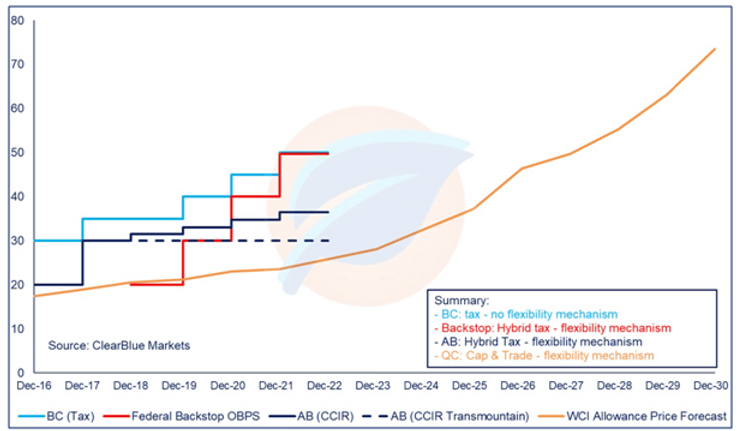
In the era of the Paris Agreement, every participating country will be taking action to cut emissions in a way which best suits its economy. For some, like Mexico, this action will be a continuation of things which were already in motion in 2015, while for others such as Canada, it will be new ideas and approaches developed ina the past few years. Below are two profiles of how the national governments of these two North American nations are approaching carbon pricing as they work towards their Paris contributions.
ClearBlue Markets' Case Study: Carbon Pricing, Canada-Style
The Canadian Federal Backstop is comprised of a two-tiered system: the Output Based Pricing System (OBPS) and the Carbon Levy. The programme is currently imposed wholly or in part in provinces and territories that did not implement an equivalent carbon pricing programme, as determined by the Federal government. Manitoba, Ontario, New Brunswick, Yukon and Nunavut are Backstop jurisdictions. British Columbia, Quebec, Nova Scotia, Northwest Territories, and Newfoundland and Labrador have their own, federally approved, provincially administered carbon pricing systems. Saskatchewan and Prince Edward Island have province-specific hybrid programmes. Alberta has its own mechanism for large emitters and will have the Levy imposed as of 1 January 2020, as stated by the Federal government.

Figure 1: 2019 Carbon prices across Canada

Figure 2: Carbon prices in Canada forecast
The carbon levy applies to fossil fuels in backstop jurisdictions. The levy started at C$20/tonne of CO2e in 2019 and will increase by C$10 on 1 April of each year until 2022, when it reaches C$50/tonne of CO2e. Under the OBPS stream, industrial facilities with annual emissions of 50,000 tonnes of CO2e or higher will face a carbon price on the portion of their emissions that are emitted in excess of a specified limit. These emissions limits are based on Output Based Standards (OBS), which are calculated as a percentage of the national average of sector’s emissions per unit of production. The OBS vary between sectors and are also based on emissions-intensive, trade-exposed (EITE) measurements. Facilities that emit below their emissions limit will generate surplus credits that can be sold or used for their own compliance obligation. Compliance for mandatory facilities began as of 1 January 2019. Industrial facilities with emissions of 10,000 tonnes CO2e or higher can voluntarily participate by opting in to the OBPS.
Compliance options for covered OBPS facilities include any combination of surplus credits, offsets or paying the excess emissions charge which will mirror the levy price. Compliance units, such as offset and surplus credits, represent a lower cost compliance option for covered facilities. Offsets from existing provincial offset programmes, known as Recognized Units, can be used for compliance in the OBPS.
It is expected that credits from agriculture, waste, land use and forestry project types in the BC, Alberta and Quebec’s offset programmes will be prioritised. A federal offset programme is currently being developed to increase the supply of offsets available to OBPS participants. Regulated facilities can use compliance units such as offsets and surplus credits to cover 100% of their compliance obligation in the first three compliance years. The usage limit for compliance units drops to 75% for the 2022 compliance period.
The Federal Backstop is revenue neutral, meaning the proceeds will be returned to households, industry, institutions, and small and medium sized businesses in the jurisdiction from which they were collected to support climate action. The Federal Backstop will undergo a programme review in 2022.
The constitutional justification for the implementation of the Greenhouse Gas Pricing Pollution Act (GGPPA), which underpins the OBPS and Carbon Levy, is currently being challenged in court. Ontario and Saskatchewan have launched different constitutional challenges, both of which were rejected in their respective Provincial Courts of Appeal, but both have been appealed to the Supreme Court of Canada. Alberta is also launching its own challenge and Manitoba has filed for judicial review of the programme.
With the upcoming federal election in October, the continuation of the Federal Backstop system remains uncertain as the Progressive Conservative Party plans to repeal the current system and implement their own plan to reduce emissions, if elected. With a majority government, the Progressive Conservatives would be able to repeal both the carbon levy and OBPS streams of the Federal Backstop. This potential election result will cause uncertainty for regulated entities. However, the Green Party, New Democratic Party and Liberal Party are all supportive of carbon pricing. Based on their election platforms, the Green Party would remove the OBPS stream to make a one price for all system, while the New Democratic Party would keep the current Federal Backstop with some enhancements. If re-elected the Liberals will keep the current system unchanged. Due to this uncertainty, it is essential for regulated entities to take a proactive approach towards carbon pricing position management.
Read the full IETA Insights article here (including the case study on emissions trading in Mexico)
